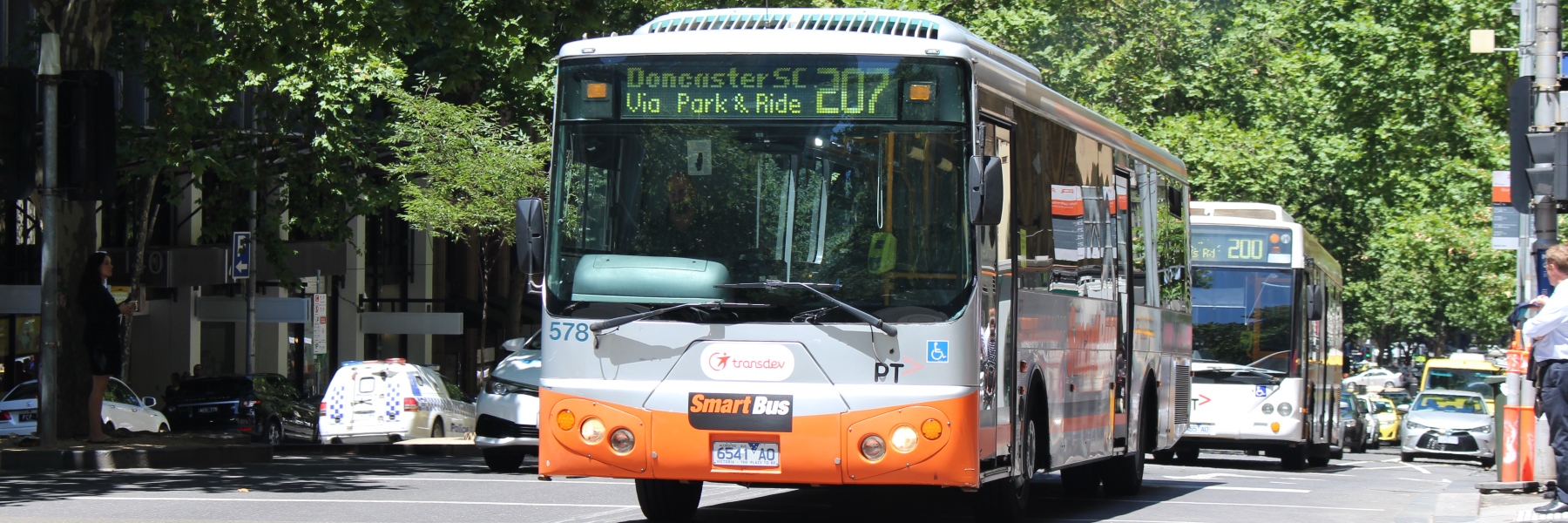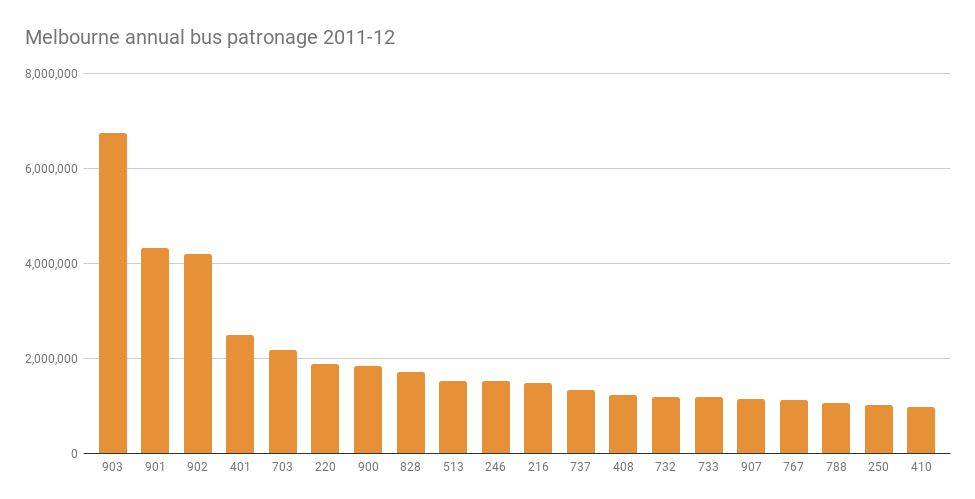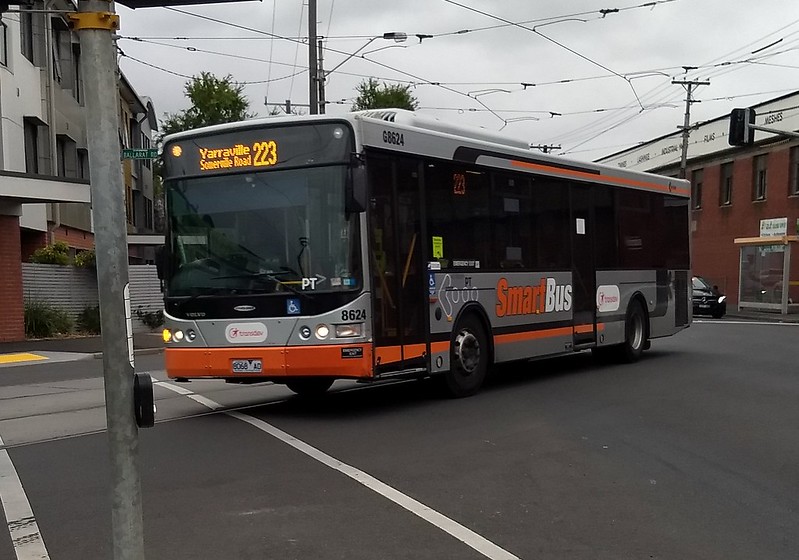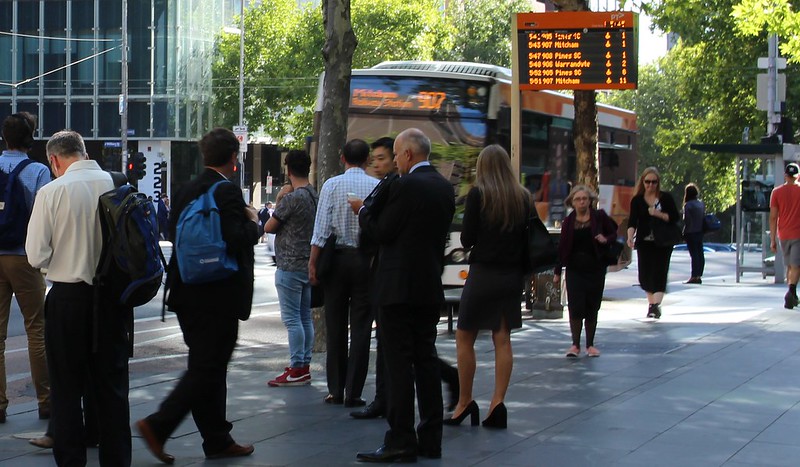Smartbus was devised in the dying days of the Kennett government originally as a mostly hardware-based upgrade: traffic priority, real-time information at stops, distinctive bus stop signs and buses.
Originally it didn’t include service upgrades (which sparked derision from the PTUA at the time), but this was changed early on during the Bracks government, with a trial on routes 703 and 888/889 (now 902).
It was a success, with patronage growing strongly. In 2006 the Bracks government announced more Smartbus routes, including four orbital routes (of which two and three-quarters were eventually built) and four Doncaster area “rapid transit” routes under the sub-brand “DART”.
Most of these replaced existing routes, but they’re now some of the busiest bus services in Melbourne.
This old data (which was the most recent published by PTV, and has now disappeared off their web site) shows that Smartbus (90x and 703) make up 5 of the top 7 routes — in part due to their length, no doubt.
(Monash Uni shuttle route 601 is probably ranked at about 7th, but the figures are so old, it’s not included, as it only started in late 2011.)
Silver and orange
Part of the appeal, apart from a better quality of service, was a distinctive silver livery, to set Smartbus routes apart from others.
Transdev, which operates most of the Smartbus routes, seems to be doing their best to kill it off.
Regular orange buses are turning up regularly on Smartbus routes.
Smartbus-liveried buses are turning up regularly on non-Smartbus routes.
Transdev of course have well-publicised problems with their fleet, which has led to a shortage of buses. But you also see these issues on weekends, when there should be plenty of spare vehicles. (The above photo is from a Saturday. That day, at least two Smartbus liveried-buses were observed running on route 223.)
Ventura has also been spotted occasionally running regular orange buses on Smartbus route 900, and they also run route 703, one of the original trial Smartbuses, which has never been upgraded to reach the supposed Smartbus service standard, and always runs orange buses (albeit with internal passenger information displays, which are only seen on Smartbus routes).
Is it time to ditch the special livery?
There might be some benefit to having a distinctive Smartbus livery in terms of attracting new users, but I don’t think it’s ever been quantified.
There is, self-evidently, a cost to bus operators of having a specific fleet of buses that can only be run on certain routes. This is the same reason they are reluctant to run mini-buses at quiet times – as this video from Florida notes, it would involve having an entire separate fleet for particular runs.
Should all buses be Smartbuses?
Smartbus routes are not actually the most frequent on the network, so the current distinction is somewhat arbitrary.
What if we gave all bus routes the benefit of Smartbus technology?
One benefit of Smartbus is real-time information at stops, but data feeds for this are now available for almost every Melbourne bus route (via the PTV app and others).
Maybe where regular and Smartbus routes share stops, they should be displaying all routes on the Smartbus kerbside signs?
Perhaps they’re already trialling this. A couple of weeks ago I spotted this displayed on a Smartbus sign at Caulfield Station – it was alternating between non-Smartbus route 624, and Smartbus route 900. (Yes, refer to printed timetable isn’t very useful. In fact, that default message should probably now be “refer to printed timetable or PTV app”.)
Another Smartbus amenity not currently seen on other routes is passenger information displays inside the buses, alongside automated announcements for each stop.
During my UK trip last year I found similar displays in every single London bus that I rode. I found it helped a lot when navigating an unfamiliar route.
This is also increasingly standard on Melbourne trams.
The obvious question is: why not here on every bus? This would also assist ensuring those with hearing or vision difficulties are informed about their location.
As for the liveries themselves… arguably it is useful to distinguish between bus routes by more than just the number. But equally there’s value in a uniform fleet, to emphasise there’s a network.
Perhaps the answer is to make more route number displays standard on all new buses — not just the front, but also the side and rear too. Make them super prominent.
And perhaps some innovative new way of providing individual route markings/colours (within the standard orange design) could be found, such as a coloured stripe or other design along the side that can be displayed clearly, yet easily changed when the bus gets switched to another route.
All options worth exploring.
Of course, putting more automated information at stops and on buses won’t solve issues of poor scheduling, infrequent services, spaghetti-like route structure, on-road delays (and a lack of traffic priority), cleanliness, and reliability…
But starting a rollout of Smartbus features onto every bus route — including regional town buses — would be a step forward to providing an easier to use bus network.







14 replies on “Is the Smartbus branding dead? Why not make every bus a Smartbus?”
Yep, improve the service and not worry about the paint job!
Canberra have an excellent information system inside their buses. They have a large TV screen that shows the next few stops and then the last stop with estimated travel times to them, all of this accompanied by a voice over announcement. A very good system, especially for tourists or if you are new to the network/ route. The estimated travel times also seem to be very accurate and every single bus has the screen, even the oldest ones!
Last year PTV did trialled passenger information systems on board non-Smartbus routes 477, 478, 479, 482, 484 and 543 – all operated by Tullamarine Bus Lines:
https://www.ptv.vic.gov.au/news-and-events/news/ptv-testing-new-passenger-information-on-board-buses/
Yes, all highly patronised bus routes should be upgraded to the SmartBus standard, but I’m not holding my breath, there is a long way to go just to make Melbourne’s buses even up to the “standard” times of 6AM-9PM seven days a week, which really should be extended to midnight to match trains and trams. I suspect my local 742 will remain every 30/40/60 minutes until I’m a pensioner, despite it serving Eastland, Ringwood Square, Vermont South, Glen Waverley, Brandon Park (requires a short walk), Oakleigh and Chadstone shopping centres as well as Heatherdale and Oakleigh train stations and Monash Uni.
Even the SmartBus routes are next to useless in the morning, at night, and on the weekend, where they run every half an hour, and on Sundays they still start late and finish three hours earlier than every other day, just as they did ten years ago. And then as you say, there’s the 703, which is a SmartBus in name only. Fun fact, routes 216/219/220 run rings around the SmartBus timetables any day of the week, any time of the day (including running until midnight on Sundays), yet they aren’t SmartBuses. Their only downfall is common to every other bus and tram in Melbourne, road traffic.
Regarding the lack of silver buses, the newer SmartBuses have been rolled out in the PTV livery whilst older SmartBuses have also been repainted white and given the PTV orange wrap, I don’t think any more SmartBuses will be painted silver. I suspect the remaining buses will end up in PTV orange soon enough.
Kurt: A similar TV-based next stop display has recently been installed in a few of our C class trams. Back in the early 2000s Invicta (now Ventura) installed TVs inside a few of their buses but they only ever showed local community news, weather, ads etc. rather than being of any use to the public.
I assume the Canberra system was imported direct from Switzerland – the displays are identical to those in use across the Zurich system.
Most Cranbourne buses are still not showing real time info about 15 months after the latest route revamp. It was working before this occurred. (Thanks, you reminded me to submit feedback with PTV which I should’ve done long ago).
Speaking of the 624, I live a few minutes walk from a 624 bus stop, but even with real time info, it is so unreliable during peak times that I avoid it at all costs.
I do not think having audible announcements for each stop is a good thing as it can get annoying. If you are unsure where to go then just ask the driver to tell you on the tram (which he/she will say over the speaker). On the bus just sit close to the front and he/she will be able to assist you. It makes sense with routes like the 401 where you are having large groups of people catching the bus to the hospital, uni etc, where it may be their first time in many cases. Also the news does not publicize enough about the poor service Transdev is providing.
I caught a tram from Box Hill to Port Melbourne recently, which has no signs or announcements inside the tram, and then another tram from Port Melbourne to Spencer Street, which did.
The announcements were quite annoying actually.
They also included virtually meaningless stop numbers.
Just don’t tell them about London’s latest innovation, or we’ll get “Please hold on, the bus is about to move” every stop!
They use smartbuses on non smartbus routes on weekend due to 3 reasons
1. The shift has mix of DART & non DART routes
2. Due to way buses are parked as worry less about seperate parking areas when buses do DART & non DART
3. In case of Heatherton & Sunshine depots Saturday they are used to avoid using unreliable 500 series buses. Once take these away these 2 depots have very little spares on Saturdays
This is part of my budget submission I have put in, as part of my http://www.tranzitjim.vision website too. I have found your feedback about Tullamarine bus lines as being interesting.
ONE FLEET: I do agree with this. The only distinction really, is the internal PIDS. That should be easy to fix, and fit to all buses
I claim there to be a safety benefit too, as passengers would not need to distract the bus driver for the same information.
How hard would it be to fix this to every bus?
I do feel, that Transdev are keen to have only one fleet for all bus routes. I am somewhat supportive in that.
THE STOPS: They do need passenger information displays. Perhaps we can do a slow rollout for now, start on stops where PIDS already exist.
The mobile phone app is not a worthy alternate for many reasons. Most of which, many people do not have mobile phones. Tourists are a common group to not have mobile phones. I, am one who flatly will not get one.
As for those who do have the mobile app, why should I use my electricity, what if I want a constant update, must I sit there with my phone in my hand, easy for a thief to snatch, or constantly in my hand when I may have luggage to also hold tight to…….just to get that constant feedback that I may want some times.
OBAHN wheels. There are a number of opportunities for O-bahn type tracks. Including across bridges, making that bridge somewhat safer against terrorist drivers.
SERVICE STYLE: I am all for at least an hourly service around the clock on a whole network of routes. All week.
Naturally, these would be somewhat more frequent during the day.
Please visit http://www.tranzitjim.vision for what I have sent as my budget submission.
Pretty colours on the exterior of buses. I can’t see how there is any passenger usefulness with these special colours, unless they catch the eye in advance for possible passengers who are glued to their phone screens. There are no distinctive colourings for buses in Queen Street . You have to watch for the bus route number. Smart Bus has always seemed to be a political thing to me, that is a government promoting, or hoping, something that the public thinks is great, but is really just a bus.
Smart buses are still appearing on Transdev routes 216,219,220, which began when so many Transdev buses were put off the road.
Interesting to note that the Smart Bus passenger information displays and voice announcements still work when a Smart Bus is running on a non-Smart Bus route.
Yes, the next stop displays on SmartBus vehicles should work on all routes run by the same company. Audio announcements require that there is a file by the same name e.g. “City Road” will be announced as long as a City Road bus stop exists on a route, but for example “Croydon station” probably won’t be announced since no SmartBus route serves there (I can’t confirm this yet, whenever I catch the 380 it’s a regular bus even though I see a lot of SmartBuses on that route).
The SmartBus sign at Ringwood station still only shows the 901 and the trains. Then again, it would take forever for the sign to scroll through the ten or so bus routes that operate there (counting both 901s and 380s separately, given their alternate directions) on the current signs they use.